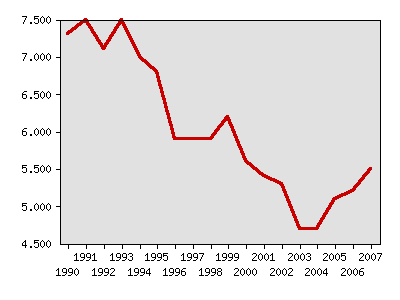Indicator 13: Infant Mortality


Rationale: Infant mortality is an important indicator because it reflects the quality of both pre- and post-natal care.
About this indicator: Since 1999, the infant mortality rate has fluctuated from a low of 4.7 per 1,000 to a high of 6.2 per 1,000. The 2007 rate was 5.5.
Infant mortality rate per 1,000 live births, total

| Year | Data |
|---|---|
| Infant mortality rate per 1,000 live births, total, Minnesota Department of Health | |
| 1990 | 7.3 |
| 1991 | 7.5 |
| 1992 | 7.1 |
| 1993 | 7.5 |
| 1994 | 7.0 |
| 1995 | 6.8 |
| 1996 | 5.9 |
| 1997 | 5.9 |
| 1998 | 5.9 |
| 1999 | 6.2 |
| 2000 | 5.6 |
| 2001 | 5.4 |
| 2002 | 5.3 |
| 2003 | 4.7 |
| 2004 | 4.7 |
| 2005 | 5.1 |
| 2006 | 5.2 |
| 2007 | 5.5 |
For comparison: The national infant mortality rate was 6.7. Kids Count reports that in 2006, five states had infant mortality rates lower than Minnesota.
Technical notes: Infant mortality is reported as the number of deaths from birth to the first birthday, per 1,000 live births.
Sources:
- Minnesota Department of Health, http://www.health.state.mn.us/
- U.S. Centers for Disease Control and Prevention, National Vital Statistics Report, http://www.cdc.gov/nchs
- Kids Count, http://datacenter.kidscount.org/
Related 2002 Milestones indicator:




